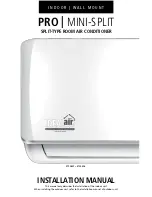
21
EVAPORATIVE-COOLED
CONDENSER cont.
WATER QUALITY
Recirculating Water Quality Guidelines:
• Cycles of concentration (the ratio of dissolved
solids in recirculated water to dissolved solids in
make-up), should be determined and monitored
frequently by a competent water treatment
expert.
• To limit cycles of concentration to maintain the
above guideline, it is necessary to “bleed” a
certain portion of the recirculated water. This is
achieved automatically with a solenoid valve
actuated by a conductivity meter set at the
desired conductivity corresponding to the desired
cycles of concentration. It should be noted that
these are guidelines and even though these
individual values are met, under certain
conditions the water quality can be aggressive.
For example, water with very low alkalinity and
levels of chlorides and sulfates approaching
maximum recommended levels can be corrosive.
Mechanical Cleaning:
Do not attempt to mechanically clean the copper
tubing in the evaporative-cooled condenser. Do
not use wire brushes or any other mechanical
device on the copper tubing. Severe damage may
result. Contact your water treatment expert for
recommendations on chemical cleaning
procedures.
Parts:
Contact your local AAON Representative for
factory authorized parts. Orders must include the
Serial Number from the product nameplate OR
visit
www.aaonparts.com
for more information.
AIR-COOLED CONDENSER
• The air-cooled condenser section rejects heat by
passing outdoor air over the fin tube coils for
cooling of the hot refrigerant gas from the
compressors. The heated air will discharge from
the top of the section through the axial flow fans.
• The condenser coils should be inspected yearly
to ensure unrestricted airflow. If the installation
has a large amount of airborne dust or other
material, the condenser coils should be cleaned
with a water spray in a direction opposite to
airflow. Care must be taken to prevent bending
of the aluminum fins on the copper tube.
REFRIGERANT PIPING FOR THE
CL SERIES
Note: This section is for information only and
is not intended to provide all details required
by the designer or installer of the refrigerant
piping between the condensing unit and air
handling equipment. AAON Inc. is not
responsible for interconnecting refrigerant
piping. Consult ASHRAE Handbook 2006 –
Refrigeration and ASME Standards.
General:
• Use only clean type L copper tubing (type K for
underground) that has been joined with high
temperature brazing alloy.
• All AAON CL condensing units have factory
furnished liquid and suction line shutoff valves.
Determining Refrigerant Line size:
The piping between the condenser and low side
must assure:
1.
Minimum pressure drop,
and
2.
Continuous oil return,
and
3.
Prevention of liquid refrigerant slugging, or
carryover
• Minimizing the refrigerant line size is favorable
from an economic perspective, reducing
installation costs, and reducing the potential for
leakage. However, as pipe diameters narrow,
pressure-reducing frictional forces increase.
















































